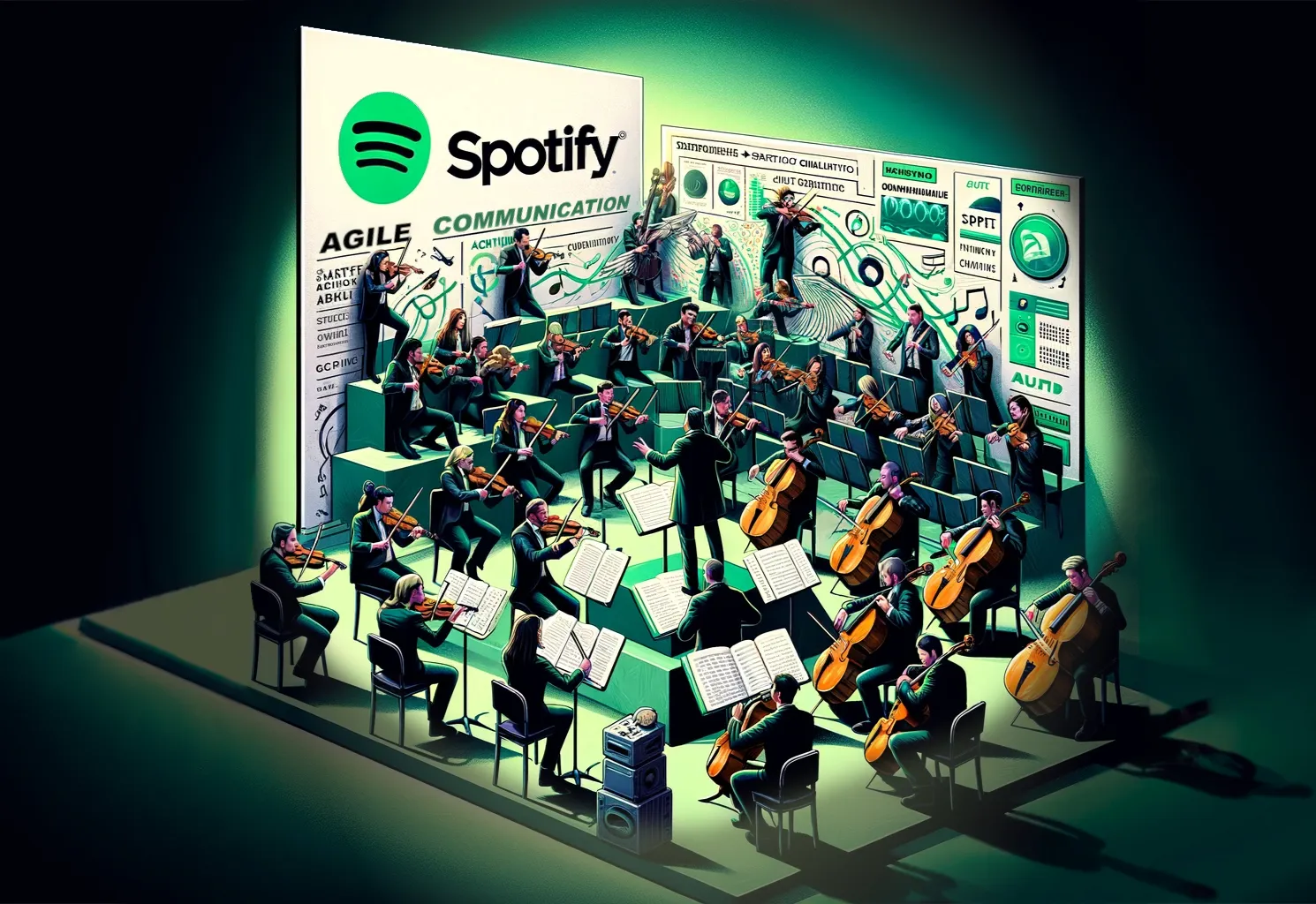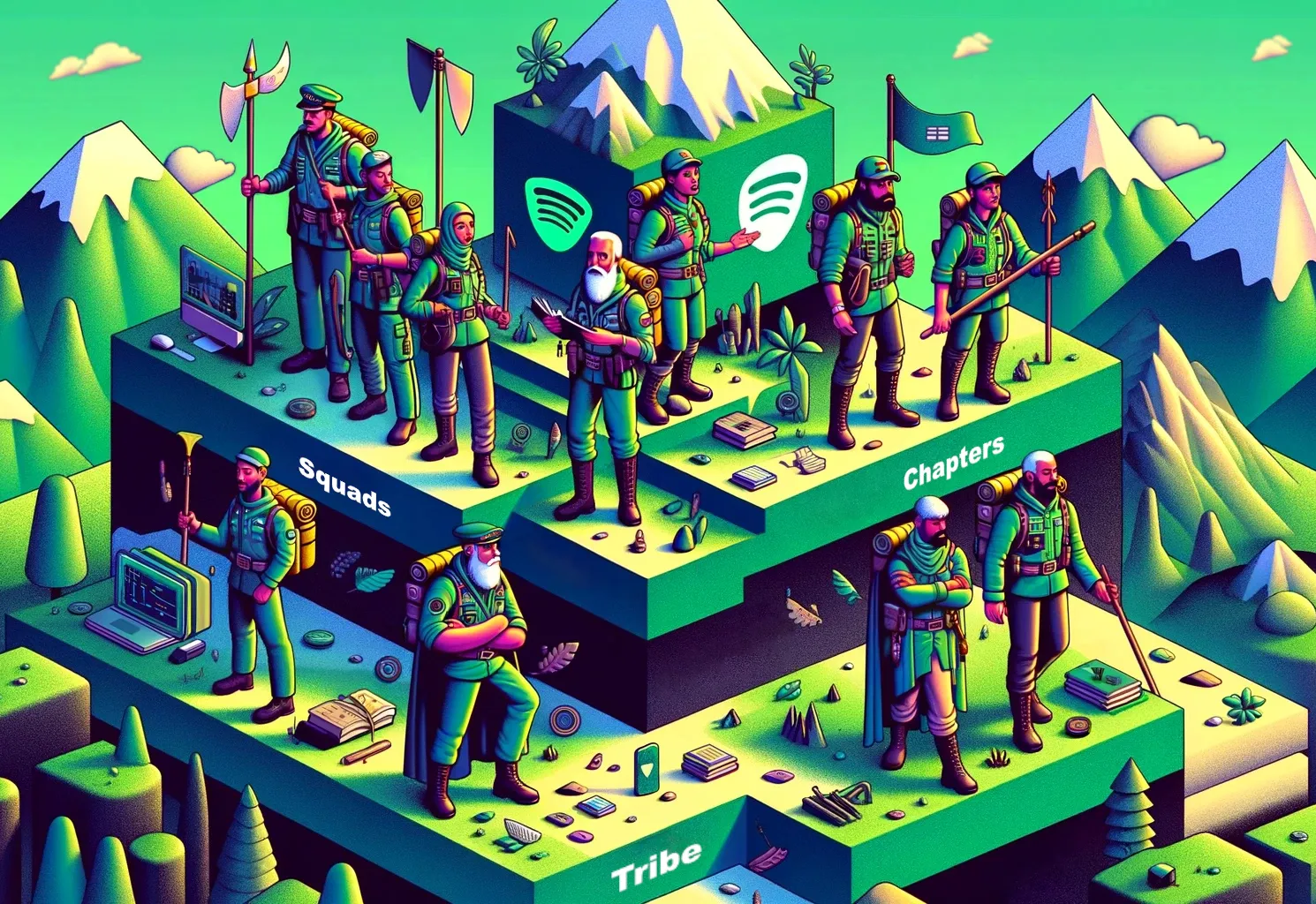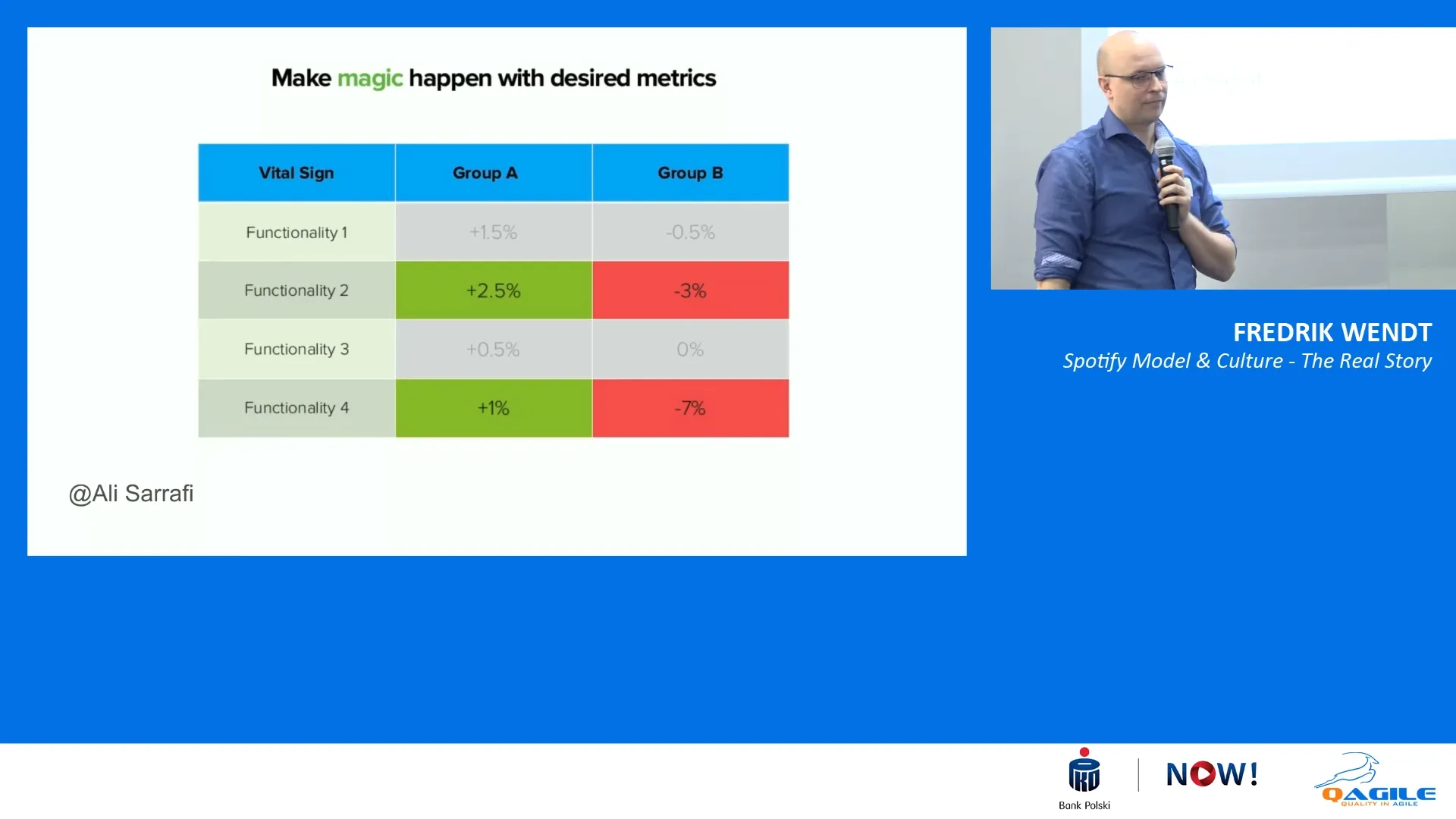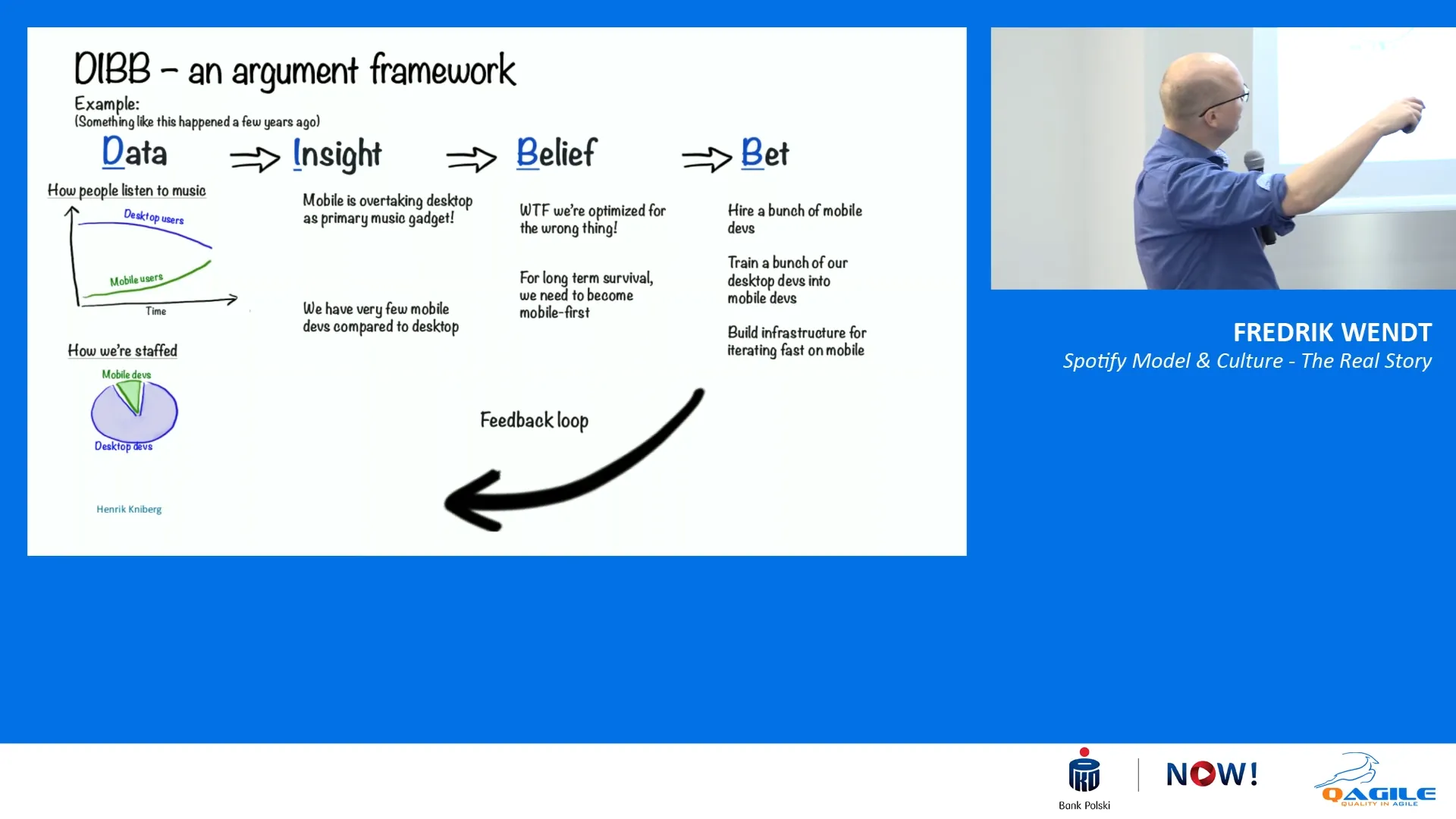Spotify Model & Culture
a true story?
Introduction
The following text serves as a personal record of information and a carefully selected summary of a presentation that I recently came across on YouTube.
My intention is to create a resource that I, and possibly you, can refer back to for inspiration and reference.
This is the first article in a series where I aim to connect the past with the present by providing updates and reflections on how these concepts and observations have evolved or remained constant over time.
Disclamer
It’s important to note that the presentation which serves as the foundation for this article was originally delivered in 17th April, 2019. The experiences described by Fredrik Wendt in the presentation were most likely from between August 2016 to February 2017. Given the rapid pace of change in our world, some of the information and perspectives shared in the video reflect a snapshot of that time, capturing the era’s zeitgeist.
As we journey through this piece, remember that while some insights may have evolved, they serve as a valuable baseline for understanding subsequent developments.
“Let’s be clear. Our way of working is unique, but it could be better.
We make mistakes and realise that we don’t have the answers to all the questions.
As we’re growing so quickly, new challenges arise every day.
The biggest challenges are to attract the right people and to harness our innovation, agility, and unique culture while welcoming 100 new employees to the team every month.”
~Katarina Berg,
(a Chief Human Resources Officer (CHRO) at Spotify)
Experimentation and Hack Week

- Core to Culture Experimentation is a fundamental aspect of Spotify’s culture.
- Boot Camp Induction The company’s boot camp program encourages rapid development and delivery.
- Hack Week The hack week event allows employees to work on innovative projects or ideas.
- Hack Week Impact Hack week projects often lead to new features, improvements, or concepts that could be implemented within Spotify’s products.
Core to Culture: Experimentation as a Cultural DNA
“Everybody has experimentation in their DNA” — At Spotify, experimentation is a vital part of the company’s culture. Employees are encouraged to constantly test new ideas, learn from the outcomes, and explore new approaches. This fosters an environment where taking calculated risks and innovating are accepted, expected, and celebrated.
Boot Camp Induction: Rapid Development and Delivery
Spotify’s boot camp is an onboarding program for new hires. It immerses them in Spotify’s culture and working methods, encouraging rapid development and delivery within a short timeframe, typically a week. The aim is to get new employees accustomed to Spotify’s pace and ethos of experimentation from the outset.
How is it going now?
According to Spotify’s Blog post from 2021, it looks like it’s still doing well, and other companies like Expedia Group are adopting the same model.
The following row is from a table that describes the proof-of-value metrics for Backstage adoption at Expedia Group:
Metric: Ship on day one
Description: Time from first commit to deploying app code in production
High Level Work Planned in Q4:
Add curriculum content to developer boot camp for new hires to leverage Backstage to create a new “hello world” app in production on day one
1
Hack Week Impact: Creativity and Innovation
“I was overwhelmed… at least 50 of those [projects] were ready to go to market” — Hack Week is an event that allows employees across the company to step away from their day-to-day tasks to work on innovative projects or ideas they are passionate about. It’s a time dedicated to creativity, experimentation, and exploring new technologies or solutions without the constraints of regular work.
Hack Week projects can be individual or team efforts and often lead to new features, improvements, or concepts that could be implemented within Spotify’s products.
How is it going now?
According to a blog post by Spotify in 2023, it appears that they’re still doing it:
“Some of our most beloved features have come out of Hack Week — including the now-essential Discover Weekly playlist, the Exclude from Your Taste Profile feature, and even Backstage itself (how meta 🤯)! For a little Spotify Hack Week history lesson, read our For The Record blog post with tips to create a successful hack week.” 2
Spotify’s culture focuses on encouraging innovation, creativity, and quick development. The Boot Camp and Hack Week not only encourage employees to think outside the box and test new ideas but also play a crucial role in keeping the company at the forefront of technological advancement and market trends.
Emphasising Cultural Aspects

- Practice Variation Spotify values autonomy and encourages Squads to find out what works best for them instead of imposing a one-size-fits-all approach.
- Mission to Focus Creative displays of squad missions keep the team focused and motivated and reinforce their sense of purpose.
- Mission for Transparency Visible missions provide insight into what each squad is working on, fostering transparency and interconnectedness within the company.
Practice Variation: “Not every squad works the same”
Spotify has a set of core practices and principles, but it understands that different teams have different needs. As a result, they allow each team to adapt to their unique context, project, and team dynamics. Spotify values autonomy and encourages teams to find out what works best for them instead of imposing a one-size-fits-all approach.
How is it going now?
According to the feedback Squads provided in 2019 for the research presented in the article from 2023 by Darja Šmite, Nils Brede Moe, Marcin Floryan, Javier Gonzalez-Huerta, Michael Dorner, Aivars Sablis titled Decentralized decision-making and scaled autonomy at Spotify 3:
“…We are a part of designing our future – what and how we build. It’s not someone else, WE are defining it”.
~ Alpha Squad from Sweden
Mission Clarity: Visible and Clear Squad Missions
At Spotify, the missions of different squads are not just abstract concepts but are made tangible and visible within the workspace. This could be through creative displays, whiteboards, or posters, making each squad’s objectives clear to all members. This practice of visually articulating missions serves multiple purposes:
- Focus: It keeps the team focused on their specific goals and how they contribute to the company’s larger objectives.
- Motivation: Creative displays of missions can also serve as a source of motivation and pride for squad members, reinforcing their sense of purpose.
- Transparency: For others within the organisation, these visible missions provide insight into what each squad is working on, fostering a sense of transparency and interconnectedness within the company.
How is it going now?
According to the article Decentralized decision-making and scaled autonomy at Spotify 3
“Vision and mission for the squad is defined by ourselves. We sit together and decided what we want to do. People want us to own more stuff, but it’ up to us to keep the scope”.
~ Gamma Squad from Sweden
on the other hand someone from Squad Alpha explained:
“We are defined by the mission of what we do and that sometimes limits us to do more. We could innovate in different places and do more, but we are limited”.
Spotify allows each team to adapt to their unique needs and values autonomy. The missions of each squad are made visible to all members through creative displays, serving as a source of motivation and fostering transparency.
Agility in Different Forms

- Technical Agility Spotify prioritises quick, quality delivery.
- Learning Continuous learning and improvement is crucial.
- Quick Pivoting To maintain relevance and competitiveness, Spotify quickly pivots to align with long-term strategies and market dynamics.
- Strategic Agility
- Involves clear and transparent communication of company goals and strategies
- Means being responsive to market trends and user behaviours, making strategic decisions that position the company for future success.
“At Spotify, we’re often testing and launching improvements and new features.
This means you might see something on the app your friend doesn’t, or get a new feature to try temporarily.”
~ Anonymous
Why has the app changed?
Source: support.spotify.com4
Transparent Strategic Planning
Strategic Agility
“Everybody understands what we’re doing” — Spotify’s approach to strategic agility involves clear and transparent communication of company goals and strategies. This ensures that all teams are aligned with the company’s vision and objectives, allowing for cohesive and strategic decision-making.
Technical Agility
At a Squad level this practice is implemented as a Mission Board mentioned previously.
Responsive to Market and User Trends
Strategic Agility
Strategic agility at Spotify also means being responsive to market trends and user behaviours. By understanding and anticipating these changes, Spotify can make strategic ‘bets’ or decisions that position the company for future success. This approach requires a deep understanding of the industry and the flexibility to shift resources and focus as needed.
Technical Agility
Being Responsive to Market and User Trends also has an impact at a more local level where by gathering and analysing metrics quickly, Spotify can learn from user interactions and refine its product in real time. This aspect of technical agility is crucial in a fast-evolving market, where user preferences and technological capabilities are constantly changing.
Adaptation to Changing Needs
Spotify’s decision to discontinue5 “Running” Feature6 shows its agility in responding to market demands. Organisational agility at Spotify involves quickly pivoting to align with long-term strategies and market dynamics, maintaining relevance and competitiveness.
Spotify is adaptable and competitive due to their technical and strategic agility. They quickly deliver quality products, learn from user feedback, communicate company goals, and respond to trends.
Evolving Culture and Decision-Making

- Balancing Predictability with Innovation Spotify adapted to external market forces in preparation for its IPO.
- Preserving Values Changed decision-making processes and structure while maintaining core values.
- Navigating Growth and Complexity Redefined roles and responsibilities and implemented more structured processes as the company grew.
Spotify has a unique reputation for being highly adaptable and responsive to external market forces. The company underwent significant changes in preparation for its initial public offering (IPO). It reconstructed its decision-making processes and organisational structure while remaining true to its core values as it continued to grow and scale its culture.
As a public company, Spotify had to find a balance between financial predictability and cultural agility. To achieve this, it had to redefine roles and responsibilities and implement more structured processes.
Spotify going public: Bevelenent or Machiavellian?
Was Direct Listing a bold move to benefit their team or a clever strategy to boost record label profits?
Join me to find out if they truly did it for the team or just for the record label's profit
In summary, Spotify adapted, changed, and balanced while maintaining its core values and facing scaling challenges.
Squad, Chapter and Tribe Structure

- Squad Formation Spotify forms squads based on their current needs and goals to remain adaptable to changes in the market.
- Chapter Lead Roles Chapter leads offer guidance, mentorship, and technical work to support their teams.
- Tribe Leadership Philosophy Tribe leaders embody servant-leadership, “They really are the servant-leader… what do you need? How can I help you?”
- Tribe Leader’s Role Tribe leaders empower teams, facilitate their needs, and create an environment for effective contribution to organisational goals.
Squad Formation: Strategic and Adaptive Formation
Spotify forms squads based on their current needs and goals, which allows them to be adaptable to changes in the market. Each squad focuses on specific aspects of the product or service, ensuring that they have the necessary expertise. These squads can be created, disbanded, or changed as needed to keep up with Spotify’s commitment to being agile and responsive.
Chapter Lead Roles
Chapter leads have diverse responsibilities to support their teams. Depending on each team’s needs, they can offer guidance, mentorship, and even hands-on technical work. Such roles help squads work together efficiently within Spotify.
Tribe Leader’s Role
Tribe leaders follow a servant-leadership approach, focusing on facilitating squads’ needs instead of directing activities. This might include budget allocation, providing necessary tools, or removing obstacles squads face. They act as coaches and enablers, empowering teams to make decisions, innovate, and take ownership of their projects. By maintaining autonomous and self-organising squads, tribe leaders create an environment where teams can thrive and contribute effectively to align with the organisation’s goals.
How is it going now?
According to Darja Šmite et al. (2023)3:
Some organizational structures have been abandoned such as chapters (Mankins and Garton, 2017), some have decreased in popularity such as guilds (Smite et al., 2019; Šmite et al., 2020), and some new structures have been introduced such as missions.
In summary, Spotify forms adaptable squads, each with specific expertise. These squads can be created, disbanded, or changed as needed. Chapter leads support their teams, and tribe leaders empower squads to make decisions and take ownership. Autonomous squads create an environment where teams can thrive.
Decision Transparency

- Decision Volume Team members make 5 to 50 decisions daily.
- Everyone in the Loop They communicate with each other regularly.
- Simple System They follow a simple system of sending decision emails to a dedicated email address.
- Concise Yet Informative The emails include details of what the team learned, the decisions made, the reasons behind them, and additional resources.
At Spotify, the team members communicate with each other on a regular basis and make around 5 to 50 decisions every day.
To keep everyone in the loop, they follow a simple system. Whenever a squad makes a decision, they send an email to decisions[at]spotify[dot]com. This way, the whole company gets to know about any changes or new directions.
The emails are designed to be concise yet informative, including details about what the team learned, the decisions they made, the reasons behind them, and additional resources for those who want more information.
How is it going now?
RFC & PR
According to Darja Šmite et al. (2023)3:
When the squad’s work impacts other squads, engineers are expected to consult the others either informally or through formalized action.
Large changes are documented in the form of so-called Requests-For-Comment (RFC) which are sent to a wider audience for feedback, to ensure that there is an agreement about the emerging changes and dependencies.
Smaller changes are handled through the GitHub pull requests (PRs).
as well as
When the squad’s work impacts other squads, engineers are expected to consult the others either informally or through so-called Requests-For-Comment (RFC) to ensure that there is an agreement about the emerging changes and dependencies.
The RFC document is typically prepared and shared with the rest of the company or the concerned tribe, open for comments and improvement suggestions for a given period.
ADR, RFC & Meetings
The Spotify R&D Engineering Blog post by Josef Blake from 2020
When Should I Write an Architecture Decision Record 7
provides clear guidance on when to create an Architecture Decision Record (ADR):
Spotify’s team sends decision emails to a dedicated email address with concise details and additional resources to keep the whole company informed, and allow eveyone to participate in further discussion.
Coaching is natural

- The Availability At Spotify, coaches and mentors are available to all employees.
- The Main Function The coach is to help identify essential needs and to find the answers.
- The Frequency One-on-one sessions with leaders or coaches are available weekly to all staff.
At Spotify, employees have access to a supportive and nurturing environment where coaches and mentors are always available to lend a helping hand.
The coaches utilise a structured approach called the “four stances of a scrum master” to provide guidance to employees through facilitating, teaching, mentoring, and coaching.8
The primary role of a coach is to assist employees in identifying their essential needs and help them find the answers they seek. Although coaches may not have all the answers, they can help employees by asking the right questions.
To facilitate this, weekly one-on-one sessions with chapter leaders or coaches are available to all staff members. These sessions help employees determine the next steps in their career development and provide a safe space to discuss any concerns or challenges they may be facing.
How is it going now?
Read Agile Coaching (AC) at Spotify: Shining a Light on the AC Career Framework 9 on the Spotify Engineering Blog to learn about their career framework for agile coaches.
The framework includes accountabilities, coaching levels, and three pillars of competency.
Discover how it has improved performance, career growth, and team service.
At Spotify, coaches use a structured approach to provide guidance to employees. They help employees identify their needs and find the answers they seek. Weekly one-on-one sessions with coaches are available to all staff members to discuss career development and concerns.
Post-mortems

- Part of the Culture Post-mortems are common when things go wrong.
- Acknowledge and Prevent These are for acknowledging problems and finding solutions to prevent them from happening again.
When things go wrong at Spotify, it’s common to have a post-mortem discussion. This is not a complaining session but rather a way to acknowledge problems and come up with solutions to prevent them from happening again. It’s a process of learning from mistakes and taking action to improve things.
This article from 2013 delves into Spotify’s incident management, detailing a major outage and the subsequent analysis and remediation efforts. It highlights the importance of learning from failures, identifying root causes, and implementing effective solutions to prevent recurrence.
Incident Management at Spotify
Spotify had a big problem with their Popcount service, which made it hard for people in Europe to listen to music. The issue was caused by an old code in the desktop client that kept trying to connect to the Popcount service, which made it crash.
They fixed it, but there was another problem because some services depended on each other in unexpected ways. To solve it, they blocked some servers that weren’t working and made some changes to the way they log things. Spotify is learning from their mistakes and making changes to avoid this happening again.10
Conclusion
It’s important to test things properly, fix problems quickly, and make sure everyone knows what to do.
How is it going now?
“When we take the time to run an incident review (we used to call this a postmortem), we have an opportunity to investigate and internalize how and where the system broke down.
While we can read code and docs and hypothesize where the issue stemmed from, analyzing a failure is an opportunity to correct our understanding and bring it closer to reality. Leveling up our engineers in this way leads to better outcomes.
This is how we buy productivity later, by sacrificing some of it today.”
11
~ Clint Byrum, 2022
(a Staff Engineer at Spotify)
Metrics and Data-Driven Approach

- Engagement & Platform Metrics are essential for understanding user engagement and platform health.
- Valuable Insights Metrics can provide valuable insights for improving the user experience and developing effective marketing strategies.
- Performance Metrics Monthly Active Users (MAU) and Daily Active Users (DAU) are two significant metrics.
- Being data-informed The DIBB Framework (Data, Insights, Beliefs, Bets) guides decision-making by combining data, insights, beliefs, and strategic bets.
To ensure that the service is performing well and meeting the needs of its users, it is crucial to gain a deep understanding of user engagement and the overall health of the platform.
Metrics are a powerful tool that can provide valuable insights into how frequently users interact with the platform, how they navigate through it, and what features they find most useful.
By analysing these metrics, we can identify areas for improvement and make data-driven decisions to enhance the user experience. This information is not only useful for product improvements, but also for developing effective marketing strategies that resonate with the target audience.
Performance Metrics: DAU and MAU

Spotify made this very clear that these are two of the most critical metrics:
MAU — Monthly Active Users
DAU — Daily Active Users
Whatever change you make to our product, these two are not supposed to go down.
It’s really important to stress how significant this simple metric is and how it directs the development of their product.
You will see something like this [table] whenever they make changes, do A/B testing, etc.
This method enables the swift evaluation of the effects of any changes that have been implemented.

My Reflection
In my experience, the significance of gathering metrics effectively and efficiently cannot be overstated. Yet, astonishingly, very few companies excel in this area. The complexity of the process can severely delay the feedback loop, which is essential for informed decision-making. Moreover, when metrics collection relies on manual tasks, it introduces an additional layer of delay. This manual intervention not only slows down the process but also increases the likelihood of errors and oversights.
What often happens is that if the process isn’t automated and if there’s no dedicated focus on generating and analysing these feedback reports, a data-driven approach becomes more theoretical than practical. It’s easy for such practices to be sidelined, forgotten, or abandoned altogether.
Efficient metric gathering — characterised by automation, ease of presentation, and minimal manual intervention—stands in stark contrast. Manual tasks, particularly when not the primary responsibility of the person assigned to them, introduce friction and are prone to being overlooked. This neglect is usually not due to negligence but to the process not being integrated seamlessly into daily workflows.
The essence here is that for metrics to drive decision-making, they must be gathered and presented in a manner that is as streamlined and automated as possible. This approach minimises delays, reduces the risk of human error, and ensures that data-driven insights are consistently front and centre in strategic discussions.
It’s about creating a system where data flows freely, insights are readily accessible, and the value of metrics is not just recognised but fully leveraged.
Read more about the metrics from 2016 and 2023
Then
This article details Spotify’s growth from 2006 to 2017. It covers their strategies, financial performance, and competition.
Follow this link for a deep dive into the analysis and charts of the following metrics:
- Spotify: Total vs Paying Users
2011 to 2017
- Spotify MAU Growth by Geography
Q1 2016 to Q4 2017
- Premium Monthly Churn
Mar 2016 to Dec 2017
- Spotify Monthly ARPU
2013 to 2017
- and more…12
Now
Read about Spotify’s journey, from its inception to its diversification into podcasts and live audio.
The article covers Spotify’s freemium model, strategic expansions, controversies, key statistics, revenue growth, subscriber insights, and demographic breakdowns, all backed by the following metrics:
- Spotify average revenue per user (ARPU)
2015 to 2023
- Spotify annual users
2015 to 2023
- Spotify age demographics
2023
- and more…13
DIBB Framework Utilisation: Data, Insights, Beliefs, Bets

That’s a bad match.
The insight is that mobile is overtaking desktop, so we should change.
We’re optimising for the wrong thing, so let’s increase the number of mobile developers and retrain people to build infrastructure to iterate fast on mobile.”
This framework guides decision-making by combining several key elements.
Data
Objective facts and figures collected from the platform provide a solid foundation for understanding user behaviour and preferences.
Insights
Interpretations drawn from the data help to uncover trends and patterns that might take time to be noticeable.
Beliefs
The team’s hypotheses or assumptions are often based on data insights, experience, and intuition.
Bets
Strategic decisions are made based on data, insights, and beliefs. These bets are informed risks the company takes to pursue innovation and growth.
Insight to Action
The data was clear — mobile was king.
This insight led to a belief that they needed to pivot towards a mobile-first development approach.141516 To do this, they had to invest in training their desktop engineers in mobile technologies.
It is important to track user engagement metrics for improving products and marketing strategies effectively. The most critical metrics are Monthly Active Users (MAU) and Daily Active Users (DAU). The metrics gathering process should be thorough, easy to comprehend, and provide quick feedback.
Spotify uses the DIBB framework to be “data-informed” instead of solely “data-driven”. This approach acknowledges the role of data in decision-making but also values human insight and intuition. This enables a more flexible and responsive response to changing market trends and user requirements.
Architecture First

- Smooth Progress Investing in architecture ensures smooth progress by enabling the team to iterate and update efficiently.
- Long-Term Value Cost Such architecture may be costly at first, but the long-term benefits are worth it.
- Competitive Advantage Innovative architecture drive product evolution and competitive advantage.
Innovation through Architecture
The core issue was the pace. Spotify’s development process was designed around quickly trying new ideas, conducting A/B tests, and iterating based on user feedback. This process was seamless for desktop applications but became a bottleneck for mobile development due to the slow, regulated update process. The quest was to maintain agility in a mobile-first strategy without burdening users with frequent updates, which would be impractical and disruptive.
To achieve this, Spotify leveraged server-side updates, allowing the client application to receive and execute updates in a similar way to web technologies. This clever approach enabled them to bypass the traditional mobile app update cycle, ensuring that users always had access to the latest features and improvements without the need for constant, manual updates.
A Strategic Investment
“Invest super heavily in architecture that supports teams to do the valuable work.”Implementing this new architecture was neither cheap nor straightforward. It required significant investment in creating the necessary platform and tools that would enable such a seamless, server-side update mechanism.
However, the benefits were clear. This strategic decision allowed Spotify’s teams to maintain their agility. They were able to rapidly iterate and deploy new features and fixes. This level of investment in infrastructure to support innovation is rare, setting Spotify apart as a leader in technological adaptability and user-centric design.
The key takeaway is the importance of designing systems and architecture, prioritising flexibility, efficiency, and user experience.
Organisations can maintain a competitive edge by investing in architecture that enable rapid iteration and updates while minimising developers’ inconvenience.
Moreover, such investments facilitate smoother progress and contribute to long-term success and innovation.
Technical and Product Ownership

- Balanced Ownership Roles Introduction of technical owners complements product owners
- The Technical Owner Focuses on the ‘how’ of product development complements.
- The Product Owner Focuses on the ‘what’ and ‘why’.
- Impact on Product Development Creating a product that is both high-quality and user-centred.
Balanced Ownership Roles
Dual Ownership System
When it comes to developing a product, it is necessary to have a solid understanding of both the technical and business aspects of it. That’s why Spotify introduced a dual ownership model with technical and product owners.
By dividing responsibilities among different owners, the decision-making process becomes more refined and informed. Each owner brings their unique area of expertise to the table, which allows for a more holistic approach.
Technical Owners
The technical quality of a product is vital to its success. Technical owners ensure every aspect necessary to facilitate it is considered at the planning level to make the implementation smooth without significant scope creep.
They focus on a range of technical aspects, including code quality and architecture, to ensure they can scale to meet the higher demand in the future.
Product Owners
They concentrate on the market, business, and user acceptance aspects of the product. This includes understanding user needs, market trends, and business objectives and then translating these into actionable product features and improvements.
Additional Role: Road Manager
“Have a “Road manager” for the retro to help organize and drive the effort and schedule various regular check-ins with retro working group, stakeholders, etc.”
~ Henrik Kniberg, 2015 17
In addition, the road manager is responsible for collecting all the data from A/B tests. They conducted a weekly review to ensure its accuracy.
After the review, the Road Manager shares the results with all the stakeholders involved in the project.
Not formally defined
Based on the available information, it seems that this role is very specific to its context. It can be created when needed to achieve a particular goal. The person in this role is responsible for either taking actionable steps or ensuring that all necessary resources are available to achieve the goal or objective:
In the spring of 2014, at a technology leadership offsite, we decided to create a “career ladder” for Spotify and quickly drew up something simple to start with. I was made the Road Manager (driver/leader) of the effort to flesh it out and then roll it out to our large organization.
~Kevin Goldsmith, 2016 18
When looking at the hierarchy presented in the early Technology Career Steps, we can find out where the Road Manager role fits in:
In practical terms, supporting this development journey requires a more complex framework than a typical vertically-oriented hierarchy or “career ladder”.
There are three key elements in the Steps Framework:
- a Discipline,
- a Role,
- a Step.
A Role is a way in which you engage with a team, a project, or a discipline. They are not all formally defined, but there are some common ones. Examples include:
- software engineer
- tester
- road manager
- technical product owner
- chapter lead
- agile coach
~Kevin Goldsmith, 2016 19
When making a product, it’s important to understand both the technical and business aspects. That’s why Spotify created a dual ownership system with technical and product owners. This way, decision-making becomes more refined and informed, and each owner brings their unique expertise to the table.
Technical owners focus on code quality and architecture to ensure scalability.
Product owners concentrate on user needs, market trends, and business objectives.
Additionally, a road manager collects data from A/B tests, conducts weekly reviews, and shares results with stakeholders.
Long-term Commitment

- Challenges that yield results extensive development time, significant resource allocation, or continuous iteration based on user feedback and data
- Morale and motivation Employees are encouraged to focus on the larger goal.
- Feature Lifecycle They start with MVP, proceed with A/B testing, rewrite for global scale, and revisit code long term.
Spotify has a unique approach to achieving long-term goals. They recognise and accept the challenges that come with them, such as:
- extensive development time,
- significant resource allocation,
- or continuous iteration based on user feedback and data.
Facing those challenges, however, is vital for the company’s long-term success and sustainability. They understand that certain innovations or improvements take time to develop and may not yield immediate results.
To maintain morale and motivation, Spotify emphasises the importance and potential impact of these initiatives. Employees are encouraged to focus on the larger goal and the positive change their work contributes to.
Draft to test, rewrite to scale
When the feature reaches an MVP stage, the team decides whether it should be released to the public. After conducting A/B testing, they gradually introduce the feature to a wider audience.
That often means rewriting parts to allow for global scale because they don’t need to write for global scale right away before they know it’s a good idea.
A team will revisit the code for a long time, which can sometimes be demoralising. However, everybody understands its value.
They accepted it.
Spotify emphasise the importance of initiatives and encourage employees to achieve long-term goals. When a feature reaches MVP stage, they conduct A/B testing and gradually introduce it to a wider audience. The team revisits the code for a long time, which can be demoralising, but everybody understands its value.
Conclusion
In summary, the video has provided additional details about the Spotify Model. However, as it was presented in 2019, we must seek more recent field reports to understand how the concept has evolved over time.
Source: https://www.youtube.com/watch?v=ar4lq1l8pAc
About the speaker
Fredrik Wendt was employed at Spotify from August 2016 to February 2017.
LinkedIn: linkedin.com/in/fredrikwendt/
References
-
Kumar, S. and Expedia Group. (2021)
How we measure backstage proof of value at Expedia Group,
Spotify Backstage.
Available at: https://backstage.spotify.com/blog/measuring-backstage-proof-of-value-at-expedia/
(Accessed: 14 March 2024). ↩ -
Da Costa, M. (2023)
How Spotify uses Skill Exchange to power our Hack Week,
Spotify Backstage.
Available at: https://backstage.spotify.com/blog/skill-exchange-hack-week/
(Accessed: 14 March 2024). ↩ -
Šmite, D. et al. (2023)
Decentralized decision-making and scaled autonomy at Spotify,
Journal of Systems and Software.
Available at: https://www.sciencedirect.com/science/article/pii/S0164121223000444
(Accessed: 14 March 2024). ↩ ↩2 ↩3 ↩4 -
Why has the app changed? (no date)
Spotify.
Available at: https://support.spotify.com/uk/article/why-has-the-app-changed/
(Accessed: 14 March 2024). ↩ -
@meahtenoha (2018)
Retirement of our running feature,
The Spotify Community.
Available at: https://community.spotify.com/t5/Content-Questions/Retirement-of-our-Running-Feature/td-p/4383603
(Accessed: 14 March 2024). ↩ -
Moton, T. (2018)
Spotify running review: Retirement for Spotify running,
Tunefab.
Available at: https://www.tunefab.com/spotify/how-does-spotify-running-work.html
(Accessed: 14 March 2024). ↩ -
Blake, J. (2020)
When should I write an architecture decision record,
Spotify Engineering.
Available at: https://engineering.atspotify.com/2020/04/when-should-i-write-an-architecture-decision-record/
(Accessed: 14 March 2024). ↩ -
Dulin, M. (2022)
Facilitating, teaching, mentoring, and coaching,
Agile Ambition.
Available at: https://www.agileambition.com/facilitating-teaching-mentoring-coaching/
(Accessed: 14 March 2024). ↩ -
Siseman, F., Connor, A.R. and Lemon, C. (2023)
Agile Coaching (AC) at Spotify: Shining a light on the AC career framework
Spotify Engineering.
Available at: https://engineering.atspotify.com/2023/01/agile-coaching-ac-at-spotify-shining-a-light-on-the-ac-career-framework/
(Accessed: 14 March 2024). ↩ -
Poblador i Garcia, D. (2013)
Incident management at Spotify,
Spotify Engineering.
Available at: https://engineering.atspotify.com/2013/06/incident-management-at-spotify/
(Accessed: 14 March 2024). ↩ -
Byrum, C. (2022)
Failing forward - how we grow from incidents,
Spotify Engineering.
Available at: https://engineering.atspotify.com/2022/05/failing-forward-how-we-grow-from-incidents/
(Accessed: 14 March 2024). ↩ -
Goodwater Capital (2018)
Understanding spotify: Making Music Through Innovation,
Goodwater.
Available at: https://www.goodwatercap.com/thesis/understanding-spotify
(Accessed: 14 March 2024). ↩ -
Iqbal, M. (2024)
Spotify revenue and Usage Statistics (2024),
Business of Apps.
Available at: https://www.businessofapps.com/data/spotify-statistics/
(Accessed: 14 March 2024). ↩ -
Holton, K. (2009)
Spotify launches iPhone and Android mobile services,
Reuters.
Edited by R. Winchester.
Available at: https://www.reuters.com/article/idUSTRE5861AX/
(Accessed: 14 March 2024). ↩ -
Hamburger, E. (2013)
Spotify announces free streaming on Android and iPhone, but only in Shuffle Mode,
The Verge.
Available at: https://www.theverge.com/2013/12/11/5199692/spotify-announces-free-streaming-on-android-and-iphone-but-only-in
(Accessed: 14 March 2024). ↩ -
Constine, J. (2015)
Spotify makes the shift to mobile with 52% of listening now on phones and tablets,
TechCrunch.
Available at: https://techcrunch.com/2015/01/10/music-is-a-mobile-linchpin/
(Accessed: 14 March 2024). ↩ -
Kniberg, H. (2015)
How we do large scale retrospectives,
Spotify Engineering.
Available at: https://engineering.atspotify.com/2015/11/large-scale-retros/
(Accessed: 14 March 2024). ↩ -
Goldsmith, K. (2016a)
Building a technical career path at Spotify,
Spotify Engineering.
Available at: https://engineering.atspotify.com/2016/02/technical-career-path/
(Accessed: 14 March 2024). ↩ -
Goldsmith, K. (2016b)
Spotify Technology career steps,
Spotify Engineering.
Available at: https://engineering.atspotify.com/2016/02/spotify-technology-career-steps/
(Accessed: 14 March 2024). ↩